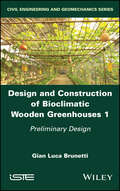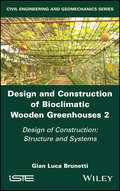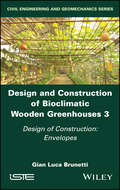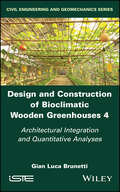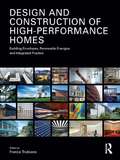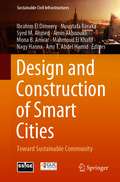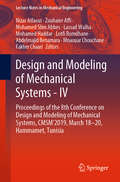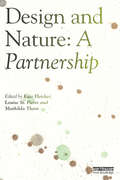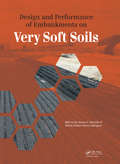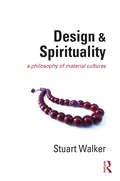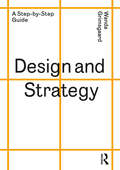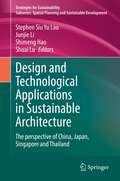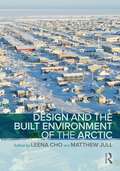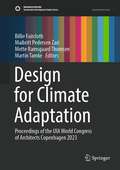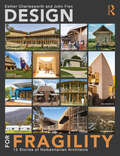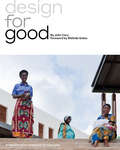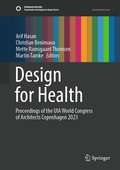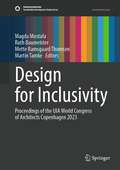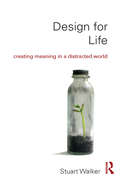- Table View
- List View
Design and Construction of Bioclimatic Wooden Greenhouses, Volume 1: Preliminary Design
by Gian Luca BrunettiDesign and Construction of Bioclimatic Wooden Greenhouses, Volume 1: Preliminary Design
Design and Construction of Bioclimatic Wooden Greenhouses, Volume 2: Design of Construction: Structure and Systems
by Gian Luca BrunettiDesign and Construction of Bioclimatic Wooden Greenhouses, Volume 2: Design of Construction: Structure and Systems
Design and Construction of Bioclimatic Wooden Greenhouses, Volume 3: Design of Construction: Envelopes
by Gian Luca BrunettiDesign and Construction of Bioclimatic Wooden Greenhouses, Volume 3: Design of Construction: Envelopes
Design and Construction of Bioclimatic Wooden Greenhouses, Volume 4: Architectural Integration and Quantitative Analyses
by Gian Luca BrunettiDesign and Construction of Bioclimatic Wooden Greenhouses, Volume 4: Architectural Integration and Quantitative Analyses
Design and Construction of High-Performance Homes: Building Envelopes, Renewable Energies and Integrated Practice
by Franca TrubianoBoth professionals and students are increasingly committed to achieving high-performance metrics in the design, construction and operation of residential buildings. This book responds to this demand by offering a comprehensive guide which features: architectural innovations in building skin technologies which make lighter more transparent buildings high performing; energy-free architectural design principles and advances in building-integrated photovoltaics; essential engineering principles, controls and approaches to simulation for achieving net zero; the advantages of integrated design in residential construction and the challenges and opportunities it engenders; detailed case studies of innovative homes which have incorporated low-energy design solutions, new materials, alternative building assemblies, digital fabrication, integrated engineering systems and operational controls. Divided into four parts, the book discusses the requisite AEC (Architecture, Engineering and Construction) knowledge needed when building a high-performance home. It also communicates this information across four case studies, which provide the reader with a thorough overview of all aspects to be considered in the design and construction of sustainable homes. With contributions from experts in the field, the book provides a well-rounded and multi-faceted approach. This book is essential reading for students and professionals in design, architecture, engineering (civil, mechanical and electrical), construction and energy management.
Design and Construction of Smart Cities: Toward Sustainable Community (Sustainable Civil Infrastructures)
by Nagy Hanna Syed M. Ahmed Ibrahim El Dimeery Moustafa Baraka Amin Akhnoukh Mona B. Anwar Mahmoud El Khafif Amr T. Abdel HamidThis book focuses on how to maintain environmental sustainability as one of its main principles, and it addresses how smart cities serve to diminish wastes and maintain natural resources by having clean green energy that is operated by new smart technology designs. Living in a smart city is not something of the future anymore, it is here, and it is being implemented all over the world. A smart city uses different types of electronic Internet of things (IoT) sensors to collect data and then use these data to manage assets and resources efficiently. The smart city concept integrates information and communication technology (ICT), and various physical devices connected to the IoT network to optimize the efficiency of city operations and services and achieve sustainable solutions to allow us to grow with proper management of our resources.Smart sustainable structures and infrastructures face the need of urban areas due to the growth of populations while in the same time save our environment. To achieve this, we need to revisit the conventional methods in design and construction and the conventional materials which are used now to optimize the design and provide smart solutions. In the past few years, the consumption of resources has been massive, and the waste produced from that consumption has been inconceivable. This is causing environmental degradation, which produces many environmental challenges, such as global climate change, excessive fossil fuel dependency and the growing demand for energy.As well as, discussing the challenges facing the civil engineering design and construction of smart cities components and presenting concepts and insight from experts and researchers from different civil engineering disciplines., this book explains how to construct buildings and special structures and how to manage and monitor energy.
Design and Modeling of Mechanical Systems - IV: Proceedings of the 8th Conference on Design and Modeling of Mechanical Systems, CMSM'2019, March 18–20, Hammamet, Tunisia (Lecture Notes in Mechanical Engineering)
by Mohamed Slim Abbes Fakher Chaari Mohamed Haddar Lotfi Romdhane Abdelmajid Benamara Mnaouar Chouchane Nizar Aifaoui Zouhaier Affi Lassad WalhaThis book offers a collection of original peer-reviewed contributions presented at the 8th International Congress on Design and Modeling of Mechanical Systems (CMSM’2019), held in Hammamet, Tunisia, from the 18th to the 20th of March 2019. It reports on research, innovative industrial applications and case studies concerning mechanical systems and related to modeling and analysis of materials and structures, multiphysics methods, nonlinear dynamics, fluid structure interaction and vibroacoustics, design and manufacturing engineering. Continuing on the tradition of the previous editions, these proceedings offers a broad overview of the state-of-the art in the field and a useful resource for academic and industry specialists active in the field of design and modeling of mechanical systems. CMSM’2019 was jointly organized by two leading Tunisian research laboratories: the Mechanical Engineering Laboratory of the National Engineering School of Monastir, University of Monastir and the Mechanical, Modeling and Manufacturing Laboratory of the National Engineering School of Sfax, University of Sfax.
Design and Nature: A Partnership
by Louise St. Pierre Kate Fletcher Mathilda ThamOrganised as a dialogue between nature and design, this book explores design ideas, opportunities, visions and practices through relating and uncovering experience of the natural world. Presented as an edited collection of 25 wide-ranging short chapters, the book explores the possibility of new relations between design and nature, beyond human mastery and understandings of nature as resource and by calling into question the longstanding role for design as agent of capitalism. The book puts forward ways in which design can form partnerships with living species and examines designers’ capacities for direct experience, awe, integrated relationships and new ways of knowing. It covers: • New design ethics of care • Indigenous perspectives • Prototyping with nature • Methods for new design and nature relations • A history of design and nature • Animist beliefs • De-centering human-centered design • Understanding nature has power and agency Design and Nature: A Partnership is a rich resource for designers who wish to learn to engage with sustainability from the ground up.
Design and Performance of Embankments on Very Soft Soils
by Marcio de Almeida Maria Esther MarquesEmbankment construction projects on very soft soil often give rise to serious problems. This volume on geotechnics and soft soil engineering therefore treats all phases of the design and construction process exhaustively, from the first investigation step to the monitoring of constructed work. The book presents the development concepts necessary fo
Design and Spirituality: A Philosophy of Material Cultures
by Stuart WalkerDesign and Spirituality examines the philosophical context of our current situation and its implications for design. It explores how modernity and our constricted notions of progress have contributed to today’s crisis of values, and argues for a re-establishment and re-affirmation of self-transcending priorities, together with an ethos of moderation and sufficiency. A wide range of topics are covered, including material culture and spiritual teachings; sustainability and the spiritual perspective; traditional and indigenous knowledge; technology and spirituality; notions of meaningful design; and how particular material things can have deeper, symbolic significance. There are also reflections on areas such as the language of design; busyness and its relationship to wisdom; design and social disparity; and traditional sacred practices. While not avoiding issues that are controversial, and sometimes hard-hitting, Design and Spirituality gets to the heart of the key issues affecting us today and presents them in a highly readable and accessible format. The author is a leading thinker in the field and he presents his arguments in a manner that invites the reader to reflect and think about where we are going, why we are going there and what really matters.
Design and Strategy: A Step-by-Step Guide
by Wanda GrimsgaardThis major practical handbook bridges the gap between strategy and design, presenting a step-by-step design process with a strategic approach and extensive methods for innovation, strategy development, design methodology and problem solving. It is an effective guide to planning and implementing design projects to ensure strategic anchoring of the process and outcome. Built around a six-part phase structure that represents the design process, covering initial preparations and project briefing, research and analysis, targets and strategy, concept development, prototyping and modelling, production and delivery, it is a must-have resource for professionals and students. Readers can easily dip in and out of sections, using the phase structure as a navigation tool. Unlike other books on the market, Design and Strategy addresses the design process from the perspective of both the company and the designer. For businesses, it highlights the value of design as a strategic tool for positioning, competition and innovation. For the designer, it teaches how to create solutions that are strategically anchored and deliver successful outcomes for businesses, resulting in appreciative clients. It includes over 250 illustrations and diagrams, tables, and text boxes showing how to move through each stage with clear visualisation and explanation. This book encourages all designers in product design and manufacturing, service design, communication design, branding, and advertising, to think beyond shape and colour to see design through the lens of strategy, process and problem solving, and all business managers, innovators and developers, to see the value in strategic design outcomes.
Design and Technological Applications in Sustainable Architecture: The perspective of China, Japan, Singapore and Thailand (Strategies for Sustainability)
by Shuai Lu Stephen Siu Yu Lau Junjie Li Shimeng HaoThis volume discusses the climate responsiveness of sustainable architecture design and technology in China, Japan, Singapore, and South Korea in recent years, addressing concepts and applications in urban planning, building design, and structural performance evaluation. The four sections of the text cover the theory and implementation of sustainable architecture within various geographic boundaries and contexts, offering an interdisciplinary assessment of the challenges faced in urban areas at different climate zones. The main topics covered are: 1) urban ecological restoration under the influence of climate environment; 2) health and human considerations of building and environment; 3) prototype optimization of sustainable building, and 4) feedback of building performance and design evaluation. The book is intended to be a contribution to the growing body of knowledge on sustainable architecture for applicable use by practitioners, city planners, field researchers, and building operators in building design, construction, usage, operation, and maintenance.
Design and impact of water treaties
by Matthew ZentnerThis study presents a unique way to utilize the existing literature to explain the success of treaties in managing hydrologic stress. Literature-derived core concepts are summarized as seven treaty mechanisms categories (specificity, uncertainty management, enforcement, communications, flexibility, integrativeness, and scale) and are hypothesized as important for shaping the institutional resiliency of a treaty. Treaty design is shown to have a relevant and important role in shaping basin management so that nations may better achieve their goals in a changing climate.
Design and the Built Environment of the Arctic
by Leena Cho Matthew JullDesign and the Built Environment of the Arctic is a concise introductory guide to the design and planning of the built environments in the Arctic region. As the global forces of change are becoming more pronounced in the Arctic, the future trajectories for living environments, city-making processes, and their adaptive capacities need to be addressed directly. This book presents 11 new and original contributions from both leading and emerging scholars and practitioners, positioning the Arctic as a dynamic, diverse, and lived place at the nexus of unprecedented socioenvironmental transformations. The volume offers key concepts for understanding and spatializing Arctic cities and landscapes; similarities and differences in the development of design and planning approaches responsive to specific climatic and cultural conditions; and historical and geographic case studies that provide unique perspectives for the management of the built environment, from the scales of a building and infrastructure to cities and territories. Altogether, the contributions expand regional Arctic design scholarship to understand how the variability of the Arctic context influences the designed urban, architecture, and landscape systems, and offer numerous lessons for design and other forms of spatial practice both within and beyond the Arctic. This is a unique resource for researchers, creative practitioners, policymakers, and community decision-makers, as well as for advanced undergraduate and graduate students.
Design by Fire: Resistance, Co-Creation and Retreat in the Pyrocene
by Emily Schlickman Brett MilliganAcross the world, the risks of wildfires are increasing and expanding. Due to past and current human actions, we dwell in the age of fire – the Pyrocene – and the many challenges and climate adaptation questions it provokes. Exploring our past and current relationships with fire, this book speculates on the pyro futures yet to be designed and cared for. Drawing upon fieldwork, mapping, drone imagery, and interviews, this publication curates 27 global design case studies within the vulnerable and dynamic wildland-urban interface and its adjacent wildlands. The book catalogs these examples into three approaches: those that resist the creative and transformative power of fire and forces of landscape change, those that embrace and utilize those forces, and those that intentionally try to retreat and minimize human intervention in fire-prone landscapes. Rather than serving as a book of neatly packaged solutions, it is a book of techniques to be considered, tested, and evaluated in a time of fire.
Design for Climate Adaptation: Proceedings of the UIA World Congress of Architects Copenhagen 2023 (Sustainable Development Goals Series)
by Mette Ramsgaard Thomsen Martin Tamke Billie Faircloth Maibritt Pedersen ZariThe book provides new perspectives from leading researchers accentuating and examining the central role of the built environment in conceiving and implementing multifaceted solutions for the complex challenges of climate change, revealing critical potentials for architecture and design to contribute in more informed and long-term ways to the urgent transition of our society. The book offers a compilation of peer-reviewed papers that uniquely connects knowledge broadly across practice and academia, from the newest technologies and methods to indigenous knowledge, community engagement, techniques for ecosystem regeneration, nature-based solutions, and more. The book is part of a series of six volumes that explore the agency of the built environment in relation to the SDGs through new research conducted by leading researchers. The series is led by editors Mette Ramsgaard Thomsen and Martin Tamke in collaboration with the theme editors: - Design for Climate Adaptation: Billie Faircloth and Maibritt Pedersen Zari- Design for Rethinking Resources: Carlo Ratti and Mette Ramsgaard Thomsen (Eds.)- Design for Resilient Communities: Anna Rubbo and Juan Du (Eds.)- Design for Health: Arif Hasan and Christian Benimana (Eds.)- Design for Inclusivity: Magda Mostafa and Ruth Baumeister (Eds.)- Design for Partnerships for Change: Sandi Hilal and Merve Bedir (Eds.)
Design for Construction: Tectonic Imagination in Contemporary Architecture
by Eric HöwelerArguing that a gulf exists between design and construction, between conceptual thinking and the constructed building, this book explores projects and practices that span the gap by thinking through materials and processes with what Höweler calls a tectonic imagination.Design for Construction is organized into 10 chapters covering topics such as means and methods, part-to-whole relationships, material research, digital design workflows, risk mitigation, construction sequencing, digital fabrication, ethical material sourcing, and circular construction practices. Höweler provides a careful analysis of over 200 buildings projects by practices including Amateur Architecture Studio, Barkow Leibinger, Diller Scofidio + Renfro, Ensamble, GLUCK+, Herzog & de Meuron, Johnston Marklee, MASS Design, NADAAA, Neri&Hu, OMA, and SANAA.Re-engagement of design and building is a means of reclaiming agency for architects as the discipline grapples with difficult questions of climate change, material scarcity, social impact, and how designers can play a more meaningful role in shaping the built environment at this moment with an eye toward the future. This book will be crucial reading for both architects and students of architecture.
Design for Dementia, Mental Health and Wellbeing: Co-Design, Interventions and Policy (Design for Social Responsibility)
by Kristina Niedderer, Geke Ludden, Tom Dening and Vjera Holthoff-DettoThis edited volume offers the first overview and reflective discussion of how design can contribute to people’s wellbeing and mental health in the context of dementia, mental illness and neurodiversity. This book explores and promotes holistic, salutogenic and preventive strategies that recognise and respond to people’s needs, wants, wishes and rights to further health, wellbeing and equality. Bringing together years of experience as designers and clinicians, the contributors to the book emphasise how design can be a collaborative, creative process as well as an outcome of this process, and they reveal how this is guided by mental health and design policy. Through its three parts, the book explores themes of ethics, citizenship and power relationships in co-design, providing an overview of current developments and approaches in co-design; of the culturally and value sensitive adaptation of design interventions and their applications, many of which are a result of co-design; and of policy and related standards in and for design and mental health. In this way, the book demonstrates how design can help to support people, their care partners and care professionals in promoting mental health and wellbeing, and it offers a rich resource on how to create a sustainable future for care in this domain. The book provides a unique and holistic overview and resource for designers, researchers, students, policy providers and health and care professionals to help support the development and adoption of person-centred design processes and interventions.
Design for Environmental Conservation: A Toolkit that Enables Sustainable, Participatory and Distributed Innovation
by Gabriela Nuri BaronThis book presents the Design for Conservation methodology, a novel approach that empowers communities and conservation professionals to collaboratively address environmental challenges. By integrating technical, relational, and cultural perspectives, this methodology emphasizes the interconnectedness of ecological systems and the importance of inclusive, participatory strategies. Designed for those eager to collaborate effectively, it offers a detailed Design Thinking framework customized for conservation efforts, emphasizing the importance of placing the natural environment at the forefront of every project. Structured in five phases—Reconnect, Understand, Propose and Validate, Plan for Impact, and Deploy—each stage offers practical tools and templates to guide users in creating sustainable solutions closely aligned with local contexts. This methodology empowers users to devise solutions that are environmentally sustainable, economically viable, and technologically feasible. Key concepts include the blending of western scientific knowledge with indigenous wisdom, the role of empathy and inclusivity in conservation efforts, and the necessity of adaptive, long-term ecological strategies. The methodology encourages users to engage with stakeholders and communities, fostering collaboration and co-creation of solutions that are both environmentally and economically viable. The book provides a step-by-step guide to planning and deploying participatory conservation workshops, offering practical tools and templates that can be tailored to any project scope. By allowing multiple worldviews to co-exist, it invites conservation managers, grassroots groups, and educators to rethink traditional methods and embrace a more inclusive, decolonial perspective. With its focus on adaptability and collective action, it serves as a guide for those committed to making a meaningful difference in the regeneration of our natural environment. This book is a vital resource for anyone committed to fostering sustainable, meaningful and impactful environmental solutions.
Design for Environmental Sustainability: Life Cycle Design Of Products
by Carlo Arnaldo VezzoliThis volume is a technical and operative contribution to the United Nations "Decade on Education for Sustainable Development" (2005-2014), aiding the development of a new generation of designers, responsible and able in the task of designing environmentally sustainable products. The book provides a comprehensive framework and a practical tool to support the design process. This is an important text for those interested in the product development processes.
Design for Fragility: 13 Stories of Humanitarian Architects
by Esther Charlesworth John FienThe demand is now urgent for architects to respond to the design and planning challenges of rebuilding cities and landscapes being destroyed by civil conflict, (un)natural disasters, political instability, and poverty. The number of people fleeing their homes and being displaced by such conflict now totals almost 100 million. Despite the massive human and physical costs of these crises, the number of architects, planners, and landscape architects equipped to work with disaster and development professionals in rebuilding in the aftermath of conflict, floods, fires, earthquakes, typhoons, and tsunamis remains chronically low. Design for Fragility expands the nascent, but rapidly growing field of humanitarian architecture by exploring 13 design responses to such conflict and displacement across 11 countries, including Australia, Bangladesh, Fiji, India, Iran, Pakistan, and the USA. Linked to this displacement is the systemic poverty that often lingers from previous colonial territories and eras, in which many of the featured projects in the book are located. This book follows Charlesworth’s Humanitarian Architecture: 15 Stories of Architects Working After Disasters (Routledge 2014), which analysed the role for architects in exercising ‘spatial agency’ while designing shelter and settlement projects for communities after conflict and disaster. Since that time, the humanitarian architecture movement has expanded globally with the prominence of design agencies including the MASS Design Group and Architecture Sans Frontières (ASF) International. Design for Fragility analyses this role of spatial agency in architecture by addressing diverse conditions of fragility across 13 built projects – from refugee housing in Uganda and an orphanage for teenage girls in Iran to a residential centre in Northern Australia for people with acquired brain injury. Each of the projects profiled in this book explore: The experiences and perceptions of fragility – or precarity – that provided a design challenge and directed the particular spatial response. The specific typology of the project, whether that be a housing, health, children’s, or a First Nations project. The personal values that influenced the architects to work on humanitarian/community projects and how consultation occurred with diverse and often contested project stakeholders. The experiences of the design team as well as project managers, occupants, and donors of the built project, exploring what they deemed successful about the project, and what, if any, were its limitations. Beautifully designed with over 150 illustrations, this practical and inspiring book is for architects, landscape architects, design educators, humanitarian and development aid agencies that are involved, or seeking to be part, of future disaster mitigation and reconstruction strategies and projects, globally.
Design for Good: A New Era of Architecture for Everyone
by John Cary"That's what we do really: we do miracles,” said Anne-Marie Nyiranshimiyimana, who learned masonry in helping to build the Butaro Hospital, a project designed for and with the people of Rwanda using local materials. This, and other projects designed with dignity, show the power of good design. Almost nothing influences the quality of our lives more than the design of our homes, our schools, our workplaces, and our public spaces. Yet, design is often taken for granted and people don't realize that they deserve better, or that better is even possible.In Design for Good, John Cary offers character-driven, real-world stories about projects around the globe that offer more—buildings that are designed and created with and for the people who will use them. The book reveals a new understanding of the ways that design shapes our lives and gives professionals and interested citizens the tools to seek out and demand designs that dignify.For too long, design has been seen as a luxury, the province of the rich, not the poor. That can no longer be acceptable to those of us in the design fields, nor to those affected by design that doesn't consider human aspects.From the Mulan Primary School in Guangdong, China to Kalamazoo College's Arcus Center for Social Justice Leadership, the examples in the book show what is possible when design is a collaborative, dignified, empathic process. Building on a powerful foreword by philanthropist Melinda Gates, Cary draws from his own experience as well as dozens of interviews to show not only that everyone deserves good design, but how it can be achieved. This isn't just another book for and about designers. It's a book about the lives we lead, inextricably shaped by the spaces and places we inhabit.
Design for Health: Proceedings of the UIA World Congress of Architects Copenhagen 2023 (Sustainable Development Goals Series)
by Mette Ramsgaard Thomsen Martin Tamke Arif Hasan Christian BenimanaThe book provides new perspectives from leading researchers accentuating and examining the central role of the built environment in conceiving and implementing multifaceted solutions to the complex challenges of physical and mental health, revealing critical potentials for architecture and design to contribute in more informed and long-term ways to the urgent transition of our society. The volume book offers a compilation of peer-reviewed papers that uniquely connects knowledge and criticality broadly across practice and academia; from new technologies, theories, and methods to community -engaged practice on many scales, and more. The book is part of a series of six volumes that explore the agency of the built environment in relation to the SDGs through new research conducted by leading researchers. The series is led by editors Mette Ramsgaard Thomsen and Martin Tamke in collaboration with the theme editors: - Design for Climate Adaptation: Billie Faircloth and Maibritt Pedersen Zari- Design for Rethinking Resources: Carlo Ratti and Mette Ramsgaard Thomsen (Eds.)- Design for Resilient Communities: Anna Rubbo and Juan Du (Eds.)- Design for Health: Arif Hasan and Christian Benimana (Eds.)- Design for Inclusivity: Magda Mostafa and Ruth Baumeister (Eds.)- Design for Partnerships for Change: Sandi Hilal and Merve Bedir (Eds.)
Design for Inclusivity: Proceedings of the UIA World Congress of Architects Copenhagen 2023 (Sustainable Development Goals Series)
by Mette Ramsgaard Thomsen Martin Tamke Magda Mostafa Ruth BaumeisterThe book provides new perspectives from leading experts examining the role of architects and urbanists in designing for inclusivity in our built environment. By focusing on themes of gender, race and ethnicity, ability, neurodiversity, age, poverty and socio-economy and the non-human, the book tackles the complex challenges that designers and scholars encounter and need to address in their works. The volume offers a diverse compilation of peer-reviewed papers related to architecture for inclusivity in various different formats, ranging from visual essays, argumentative papers and scholastic texts. It presents the notion of "availability", a concept which works to challenge the "othering" inherent in notions of inclusion and accessibility. In its introduction it presents a critical discourse around the challenges and potentials lying in the design for availability targeted towards a systemic change of our societies. The book is part of a series of six volumes that explore the agency of the built environment in relation to the SDGs through new research conducted by leading researchers. The series is led by editors Mette Ramsgaard Thomsen and Martin Tamke in collaboration with the theme editors: - Design for Climate Adaptation: Billie Faircloth and Maibritt Pedersen Zari - Design for Rethinking Resources: Carlo Ratti and Mette Ramsgaard Thomsen (Eds.) - Design for Resilient Communities: Anna Rubbo and Juan Du (Eds.) - Design for Health: Arif Hasan and Christian Benimana (Eds.) - Design for Inclusivity: Magda Mostafa and Ruth Baumeister (Eds.) - Design for Partnerships for Change: Sandi Hilal and Merve Bedir (Eds.)
Design for Life: Creating Meaning in a Distracted World
by Stuart WalkerStuart Walker’s design work has been described as life-changing, inspiring, disturbing and ferocious. Drawing on an extraordinarily diverse range of sources and informed by creative practice, Design for Life penetrates to the heart of modern culture and the malaise that underlies today’s moral and environmental crises. The author argues that this malaise is deep-seated and fundamental to the modern outlook. He shows how our preoccupation with technological progress, growth and the future has produced a constricted view of life – one that is both destructive and self-reinforcing. Based on over twenty-five years of scholarship and creative practice, he demonstrates the vital importance of solitude, contemplation, inner growth and the present moment in developing a different course – one that looks squarely at our current, precarious situation while offering a positive, hopeful way forward – a way that is compassionate, context-based, human scale, ethically motivated and critically creative. Design for Life is an intensely original contribution that will be essential reading for design practitioners and students. Written in a clear, accessible style, it will also appeal to a broader readership, especially anyone who is concerned with contemporary society’s rising inequalities and environmental failings and is looking for a more constructive, balanced and thoughtful direction.
